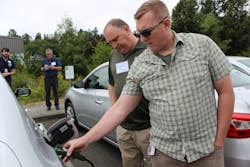S&T assesses portable instruments that identify unknown chemicals
Washington, D.C. -- Oct. 9, 2019 -- First responders arrive first on the scene when disaster strikes or terrorists attack. They often encounter dangerous conditions like smoke and chemicals. To best help in situations like these, they need to know the chemical substances present onsite. This is where analytical field instruments such as Gas Chromatograph/Mass Spectrometers (GC/MS) come into play. But to acquire such technology, first responders first need to know which GC/MSs suit both their needs and their budgets.
That’s where the Department of Homeland Security Science and Technology Directorate’s (S&T) System Assessment and Validation for Emergency Responders (SAVER) Program steps in. The SAVER Program, managed by S&T’s National Urban Security Technology Laboratory (NUSTL), conducts assessments and validations of commercial technology to save money and time for first responders when they need to purchase high-quality equipment.
“It is like a consumer report,” said John Kada, NUSTL Test Director for a recent GC/MS assessment. “Our report provides evidence of how the instruments performed with respect to the evaluation criteria.”
In July, Kada oversaw the assessment of three portable field GC/MSs used for analyzing chemical samples. Results from the assessment will be published in a report, to provide practical information for emergency responder organizations seeking an instrument best suited to their needs.
Background
Since its inception in 2004, the SAVER Program has assessed hundreds of emergency response technologies, and more than 1,000 emergency responders—law enforcement officers, firefighters, paramedics and emergency managers—have participated in those assessments. This subject matter expertise during the assessments ensures technologies will meet first responders' needs.
S&T developed the recent GC/MS assessment in cooperation with the Department of Energy’s Pacific Northwest National Laboratory (PNNL). A focus group consisting of first responders met in February 2019 to decide on the evaluation criteria. Most of the focus group members returned to participate in the July assessment.
Why do First Responders need GC/MSs?During field operations, first responders may encounter substances suspected to be narcotics, toxic industrial chemicals, or chemical warfare agents. Responders specializing in hazardous materials use GC/MS equipment to identify these hazardous substances.
These instruments have multiple applications beyond first responder needs such as in environmental monitoring and cleanup to analyze environmental pollutants, in criminal forensics to link a criminal to a crime, in law enforcement to detect illegal narcotics, and in airport security to detect explosives.
“Gas Chromatography/Mass Spectrometry is considered the gold standard of analytical methods,” said Kada. “With portable GC/MS instruments, first responders have laboratory capability right there in the field.”
GC/MSs are capable of measuring gases, volatile and semi-volatile liquids, vapors emitted by some solids (if something has a smell, it emits vapor), and can also detect trace amounts of chemical compounds and identify them.
First responders assess the GC/MSs in Seattle
During the assessment, which took place at the Seattle Joint Training Facility, Washington, Kada and his team gathered relevant data from three different GC/MS models and received feedback from a group of seven first responder evaluators with different backgrounds, including firefighters, policemen, and a member of a municipal Department of Health. A representative from each instrument manufacturer trained the evaluators and provided technical support during the event.“It is important to have documented results to demonstrate the effectiveness of our instrument in an unbiased environment utilizing industry experts as evaluators,” said Craig Crume, Training Manager, Detection at FLIR Systems, Inc., one of the vendors.
The evaluators rated the affordability, capability, usability, deployability and maintainability of each instrument according to their needs in the field. They also rated the clarity of the analysis reports those instruments generated.
The seven responder evaluators were divided into three groups. Each evaluator has had experience operating field portable GC/MS or other chemical identification devices. The responders assessed the instruments by analyzing samples from common, non-toxic, consumer products, such as over-the-counter medicines, cosmetics, and foodstuffs.
“For safety reasons, we didn’t have the responders use any dangerous chemicals,” Kada explained.
The assessment included 30 criteria and focused on testing the instruments’ general capabilities for analyzing different kinds of samples like solids, liquids, and gasses. Many questions were related to how effectively a responder can use that equipment.
Next steps
NUSTL will publish the evaluators’ feedback and results collected during the operational assessment scenarios later this year in S&T’s SAVER library. For more information, email [email protected].


